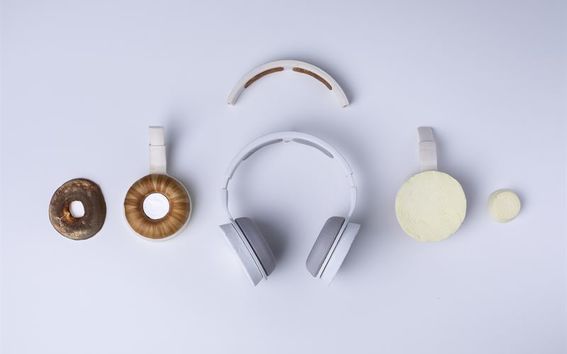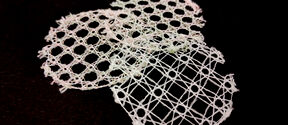Headphones made from biomaterials produced by yeast and fungal mycelium

Microbially grown materials can be used to replace oil-based materials in various everyday consumer products – such as headphones. A project team comprising research scientists, industrial designers and documentarians wanted to prove this possible and produced a set of headphones in their project Korvaa, the plastic and leather components of which were grown by microbes. VTT and Aalto University produced the materials, Aivan took care of industrial design, and Fotoni Film documented and photographed the progress of the project.
The aim of the multidisciplinary science, design and documentary project is to raise awareness about the possibilities of using microbes in sustainable production processes. The project team studies and develops various kinds of microbial processes in order to create soft, hard, foamy and leathery materials. The designers used these materials in the different headphone components. Some of the materials have never been used in industrial design before.
The project is being coordinated by Synbio Powerhouse, an innovation ecosystem set up to promote biotechnology and synthetic biology.
Putting yeast and fungal mycelium to work
Chemicals produced by microbes can be used to replace those today made in industrial processes based on fossil raw materials. Advancements in biotechnology have enabled the modification of microorganisms so that they can now produce fuels, food proteins, medicines, bioplastics and other biopolymers as well as materials for textiles and leather.
The prototype of the headphones contains six different materials, all of which were produced by means of biotechnology.
- The sound-transmission element is a fine membrane made of a microbially spun biosynthetic silk similar to a spider's web. Microbially grown protein-based silk produces extremely tough nanofibres.
- The rigid headphone components were made by 3D-printing biodegradable PLA plastic made using lactic acid produced by yeast.
- Covering the soft components of the headphones is fungal mycelium, and the end result is remarkably reminiscent of leather.
- The foamy padding for the headphones was made by combining the foaming protein produced by a fungus called Trichoderma reesei and cellulose. The protein, known as hydrophobin, is a natural surfactant, a compound that produces extremely stable foams.
VTT and Aalto University were responsible for producing the materials, Aivan for industrial design, and Fotoni Film for documenting and photographing the project. The project has received funding from the Academy of Finland's Centre or Excellence HYBER, Sitra, Synbio Powerhouse, VTT, the Jenny and Antti Wihuri Foundation and the Sophie von Julin Foundation.
Each stage of the process – including both successful or unsuccessful experiments – was documented, and the images will be on display at the Fiskars Village Art & Design biennale in Finland until 15 September and at the Helsinki Design Week 2019 exhibition between 5 and 15 September 2019.
Video about the making of the headphones (2 minutes): https://vimeo.com/337679526
Information about Synbio Powerhouse: https://www.synbio.fi
For more information:
Merja Penttilä
Professor (Adjunct Professor), Synthetic Biology, Aalto University
Research Professor, VTT Technical Research Centre of Finland Ltd.
tel. +358 40 70000163
merja.penttila@vtt.fi
Géza Szilvay, Researcher
tel. +358 40 7206129
geza.szilvay@vtt.fi
Tuula Palmén, Head of Co-Creation (Synbio Powerhouse)
tel. +358 50 4617290
tuula.palmen@vtt.fi
Read more news

Smart textiles are reshaping our understanding of materials – and interspecies communication
The PAST-A-BOT research project, funded by the European Research Council (ERC), is developing soft, intelligent textiles that could one day function as rescue robots, sound-sensing agricultural fabrics, or assistive clothing. At the same time, the project aims to rethink the way we approach materials research.
Master’s student showcases efficient color stripping of cotton fabrics
On December 9, master’s thesis student Elsa Vuorenmaa from the Textile Chemistry Group presented the results of her research on color stripping of reactive-dyed cotton fabrics.
Future makers research batteries, cryptography and plastic recycling
The Technology Industries of Finland Centennial Foundation awarded 3.5 million euros in research funding to eight projects, five from Aalto University.






